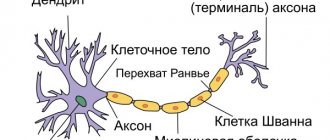Doctor Vadim Berezhnoy
Founder of the MediGlobus platform. Medical expert, Head of the department of coordinating doctors.
What is a neuroma? Neuroma (schwannoma) is a benign tumor of the auditory nerve. It occurs in 1 person in 100,000 people. The tumor grows quite slowly. But, despite this, its growth leads to hearing loss, facial paralysis, and disruption of the vestibular apparatus. If the disease cannot be cured with radiation therapy, surgery is resorted to. In this article, Mediglobus specialists will tell you how to remove a neuroma, where it is best to do it and how much the procedure costs.
What types of neuromas are there?
Neuroma
is a tumor of nervous tissue. It belongs to benign neoplasms. The disease is more common in women. Can arise from various types of nervous tissue, including nerve fibers and their myelin sheath. Specifically, traumatic neuroma occurs as a result of injury to a nerve (often during surgery). Morton's neuroma develops in the foot, and cerebral neuroma develops in the nerve cells of the human brain. However, acoustic neuromas constitute the bulk of these neoplasms.
A bony tail neuroma affects the lower spine. The causes of this pathology are not known. Visually, a spinal neuroma looks like a round, dense formation surrounded by a capsule. It grows from 1 to 2 mm per year.
With the development of a malignant process, the volume increases rapidly. This leads to compression of adjacent organs and tissues. The frequency of clinical manifestations is increasing. Spinal neuromas account for 20% of all spinal tumors.
Development of neoplasm
In medicine, 2 classifications of this disease are used. According to KOOS there are 4 stages:
- the tumor is located in the internal auditory canal;
- extends into the cerebellopontine angle, increases to 20 mm in diameter;
- extends to the brain stem, but does not put pressure on it, reaches 21 - 30 mm;
- puts pressure on the brain stem, the size of the formation is more than 30 mm.
The famous neurosurgeon Majid Samii divided stages 3 and 4 into subsections:
- T3a – tumor fills the cerebellopontine cistern;
- T3b – spreads to the brain stem;
- T4a – causes its compression;
- T4b - grossly deforms the trunk and IV ventricle.
Symptoms of acoustic neuroma
Acoustic neuroma, also known as acoustic neuroma, causes a number of symptoms due to its location. In the early stages, when the size of the tumor does not exceed 2.5 cm, the patient may experience:
- loss of hearing acuity; noise or ringing in the ears; numbness of the face on one side; impaired swallowing and articulation; change or loss of taste.
In subsequent stages, the symptoms of acoustic neuroma increase. These may include vision problems, headache, dizziness, nausea and vomiting, and mental disorders.
Neuroma affects the nervous tissue. It cannot be detected on a regular x-ray. To make a diagnosis, doctors prescribe MRI, ultrasound, audiogram, electronystagmography and hearing test.
Surgery to remove acoustic neuroma
Surgery for acoustic neuroma is performed when radiation therapy and medications do not produce the desired effect. Another indication is sudden uncontrolled tumor growth. Surgery in 95% of cases helps to avoid relapse (recurrence of schwannoma). The doctor selects the type of surgical intervention depending on the size of the neuroma and its location. The following techniques are used to access schwannoma:
- Translabyrinthine.
It involves removing the tumor through an incision behind the ear.
It is used when the neuroma is localized in the middle ear and is larger than 3 cm. During the intervention, the risk of touching the facial nerve is minimal, since the surgeon sees it well. But it should be remembered that this type of operation leads to hearing loss, since the middle ear area is removed. Suboccipital.
The tumor is removed through an incision in the back of the head.
This operation uses an endoscope to clearly see all the structures of the ear. This approach helps preserve the patient’s hearing and avoid damaging the facial nerve. The operation is used when the size of the neuroma is less than 3 cm. Access is through the middle cranial fossa.
This method is the least traumatic. It is used to remove tumors up to 1 cm that are located inside the ear canal. This technique helps preserve hearing and not damage the facial nerve.
Surgery for acoustic neuroma helps to remove it completely or partially. In the second case, after surgery, the patient undergoes radiation therapy to stop the growth of the remaining part of the schwannoma.
Treatment of neuroma
Success in the fight against neuroma lies in its timely detection, as well as correctly selected complex treatment. Postponing until later and delaying consultation with a doctor in case of increasing difficulties with hearing or loss of coordination of movements, noise in the head means exposing yourself to the risk of degeneration of a benign lesion into cancer.
Drug therapy
When a neoplasm in the auditory system is small, for example, when it is detected on brain images that were taken for other indications, oncologists do not immediately recommend removing the lesion. In the absence of pronounced negative symptoms, they recommend various medications. The purpose of the drugs is to improve the patient’s well-being, as well as help his body overcome the disease on its own.
As a rule, funds are selected from the following subgroups:
- diuretics - to eliminate excess fluid in the brain structures, reduce intracranial pressure;
- anti-inflammatory drugs - suppressing the manifestations of the inflammatory process in tissues, relieving pain;
- analgesics - overcoming pain that inevitably appears due to compression of brain structures;
- cytostatics are drugs that suppress the growth and development of tumor cells.
How is the operation performed?
The operation to treat acoustic neuroma is performed under general anesthesia. To remove the tumor, a small hole is most often made in the skull. After this, it takes some time for the bone to recover.
During the intervention, doctors use microscopes and endoscopes. They help to see the boundaries of the acoustic neuroma and the nerves. Thanks to this approach, the risk of damaging healthy tissue is reduced. The duration of the intervention depends on the size of the tumor. For small tumors - up to 1 hour, for large ones - 1.5-3 hours.
Causes of tumor formation
There are 2 types of acoustic neuroma, each differing in the reasons for its formation:
- a one-sided tumor develops under the influence of external and internal factors not related to heredity and other oncological processes;
- Bilateral acoustic neuroma depends on genetic predisposition and may appear due to spinal tumors.
Any acoustic neuroma belongs to the group of severe brain lesions and causes acute clinical attacks. Despite the fact that the tumor is located in the ears, it is in no way associated with otorhinolaryngological pathologies.
The causes of unilateral acoustic neuroma are not fully understood, but there are factors on which its formation may depend:
- radiation exposure, high voltage exposure;
- chemical poisoning;
- persistent ear diseases, including chronic ones;
- pathologies of the cardiovascular system;
- infectious diseases latent or recurrent;
- brain injuries.
Hereditary predisposition to tumors or acoustic neuroma occupies an important place in the list of causes of bilateral damage to the auditory nerve. If one parent has this disease, the risk that it will occur in the child is above 50%.
After surgery to remove an acoustic neuroma
After removal of the neuroma, the patient remains in the hospital for several days under the supervision of doctors. After 3-5 days the person is discharged. During the postoperative period, it is important to regularly consult with a doctor and undergo examinations. This is associated with the risk of complications, especially when removing large neuromas. The main complications after surgery are:
- Hearing loss. Occurs when using translabyrinthine access in surgery. Partial or complete deafness can also occur with other types of surgery, depending on where the tumor was located. Hearing loss can be restored through cochlear implantation or hearing aids. Problems with the vestibular apparatus. During the postoperative period, patients may experience dizziness and nausea. After a month, the symptoms of neuroma disappear, and only in rare cases remain for life. Facial nerve paralysis. This complication occurs when the surgeon damages the facial nerve. To avoid this, you should carefully choose a hospital and doctor. Tinnitus. After removal of a neuroma, every 5th patient experiences ringing in the ears. In 50% of people it goes away after a week, in others it can continue throughout life.
The rehabilitation period after surgery to remove acoustic neuroma
The rehabilitation period takes from 1-2 weeks to a month. The patient is advised to avoid airplane flights and is prohibited from getting his hair wet for 2 weeks. Depending on the postoperative symptoms, the doctor prescribes exercises and medications. They are aimed at correcting the vestibular apparatus, improving stability, and reducing dizziness.
After surgery to remove an acoustic neuroma, it is important to undergo regular MRI scans of the head. This will help to detect a relapse in time and prevent the tumor from reappearing.
Forecast and prevention of the disease
At stages 1 and 2 of auditory neuroma, the prognosis is very favorable - the slow benign growth of the lesion allows it to be diagnosed and eliminated in a timely manner. The five-year survival rate is about 80–90%.
When a patient presents with the third stage of a tumor defect, one should expect the formation of complications - paresis, paralysis of facial tissues, disturbances in facial expressions, and auditory/visual activity. The most unfavorable prognosis is for stage 4 of the disease, when distant secondary foci of cancer have already formed.
Specific prevention of the formation of auditory neuroma has not been developed, since the root causes of its development have not been definitively established. Experts include maintaining a healthy lifestyle with proper nutrition and adequate physical activity as methods of secondary prevention of pathology. Avoidance of individual bad habits, timely relief of neuroinfections and other somatic disorders contributes to the prevention of neuromas.
Cost of surgery to remove acoustic neuroma
The price for removal of an acoustic neuroma depends on the chosen clinic and doctor. Mediglobus specialists have selected the best countries and hospitals for treating the disease.
Price for treatment of acoustic neuroma in Israel
Israel is one of the recommended countries for neurosurgical operations. Israeli hospitals have all the equipment necessary for effective treatment of both malignant and benign tumors.
Doctors use microscopes, endoscopes, and MRI scans during interventions. This helps reduce risks and improve treatment effectiveness.
For the removal of schwannoma, Mediglobus recommends Sourasky (Ichilov), Rambam, Chaim Shiba, Hadassah and Assuta hospitals. The country's leading neurosurgeons practice here - Professor Zvi Ram
and
Menashe Zaharur
. They have been doing similar operations for over 30 years.
Israeli doctors specialize in microsurgical interventions and help patients even in critical condition. The success rate of treatment in local clinics is more than 90%.
Surgeries to remove an acoustic neuroma in Israel cost from $25,000.
Cost of treatment for acoustic neuroma in Germany
Germany has some of the best neurosurgery departments in Europe. They are certified by government health care quality control organizations. Here they use proven techniques of radiotherapy and surgery. Mediglobus patients most often go to the clinic in such German clinics as: Rechts der Isar, Vivantes, Uniklinika im. Ludwig Maximilian and Nuremberg.
The starting price for acoustic neuroma surgery in Germany starts from €23,000.
Important to remember! For treatment in Germany, 100% prepayment (deposit) is required. In some cases, it may be overestimated in case of complications. This means that the unused portion of the amount is returned after discharge if the surgery went without problems.
Prices for treatment of acoustic neuroma in Spain and Turkey
Türkiye is a country with an affordable pricing policy for neurosurgical operations. At the same time, the quality of procedures in Turkey is on par with European hospitals. Turkish surgeons perform all operations according to American protocols. Certified equipment is used here: microscopes, navigation systems.
Spain also successfully uses the latest developments in the field of neurosurgery. Leading European specialists work here: Dr. Bartolome Oliver
(Head of the Neurosurgical Department of the Teknon Clinic) and
Dr. Diego Ferrandez Sampere
(TOP specialist at the Quiron Torrevieja Clinic in the field of surgical treatment of diseases and injuries of the spinal column).
- Patients with acoustic neuroma most often go to Turkish hospitals such as: Liv Hopital, Memorial, Medical Park, Koç, Medistate, Hissar, American Hospital in Istanbul, etc. The price of the operation here is from $15,000.
- Good options for treating neuroma are clinics in Spain and the Czech Republic. Everything you need to fight this disease is here. In Spain, the operation will cost from €18,000, in the Czech Republic - €15,000.
Reviews after removal of acoustic neuroma
Where it was held:
University Clinic named after.
Ludwig Maximilian Which procedure:
Removal of acoustic neuroma
Patient age:
40 years old
Patient from:
Odessa
Anna:
“Soon it will be a year since the operation. I feel great. I completely understood that everything was behind me after 6 months (including after the second MRI). If it weren’t for the problems with the facial nerve, I would have gone back to work within 3 months after the operation. To be honest, I recovered from the operation very quickly. I spent 1 month in the hospital, most of which I waited for my turn. The operation, of course, was difficult and lasted 8 hours. I was discharged from intensive care on the 3rd day. As soon as she was discharged from intensive care, she was first allowed to sit, and the next day she began to walk. The main thing, as soon as they are allowed, is not to lie down, but to walk, walk and walk. After surgery for acoustic neuroma, the sutures were removed on the 10th day and immediately sent home. The main thing I was lucky about was the wonderful neurosurgeons! Then, after the hospital, I visited different neurologists... but even here I was lucky, because... I met 2 specialists absolutely by chance, thanks to whom I look in the mirror with pleasure again. You get used to being deaf in one ear very quickly, within 1 month.”
Surgery to remove an acoustic neuroma should be performed in certified clinics and the procedure should be trusted only to experienced surgeons. Then the risk of damaging the facial nerve and losing hearing is minimal. Mediglobus specialists can help you choose a hospital and find the best price for an operation. They will analyze the extracts and select a medical solution taking into account the patient’s wishes.
Rating: 4
NeurologyOncologyCost of treatment
Doctor Vadim Berezhnoy
Founder of the MediGlobus platform. Medical expert, Head of the department of coordinating doctors.
Lydia Artemenko
Editor
She has been working in the field of copywriting for more than 5 years, and has been writing texts about medical tourism for the website for about 1 year. For her, the ideal day off is a family walk in the park with her favorite dachshund. In his free time he enjoys handmade crafts, loves to knit, crochet, and bead embroidery.











